System and process for solid-state deposition and consolidation of high velocity powder particles using thermal plastic deformation
a technology of thermal plastic deformation and powder particles, which is applied in the direction of spray discharge apparatus, chemical vapor deposition coating, plasma technique, etc., can solve the problems of low deposition efficiency of gabel and tapphorn, ineffective commercial application economic viability of coating applicator and process disclosed in u.s. pat. no. 5,795,626, and inefficient supersonic nozzles for accelerating powder particles to high speeds. , to achieve the effect of enhancing
- Summary
- Abstract
- Description
- Claims
- Application Information
AI Technical Summary
Benefits of technology
Problems solved by technology
Method used
Image
Examples
example 1
[0110]Referring now to FIGS. 8 and 9, a bulk powder 52 is placed into hopper 48 of the powder fluidizing unit 47 and the pressure of carrier gas 4 injected into inlet port 50 is regulated to a value in the range of 50-250 psig. Carrier gas 4 may include but is not limited to air, argon, carbon tetrafluoride, carbonyl fluoride, helium, hydrogen, methane, nitrogen, oxygen, silane, steam, sulfur hexaflouride, or mixtures thereof in various concentrations. Carrier gas 4 is injected into fluidizing ports 62 and movable fluidizing port 64 of FIG. 9 and regulated to a higher pressure up to 500 psig. The differential pressure between carrier gas 4 injected into fluidizing ports 62 and carrier gas 4 injected into inlet port 50 is regulated at specific values depending on the location and depth of each fluidizing port 62 relative to bulk powder 52. Carrier gas 4 injected into a fluidizing port 62 at the greatest depth in bulk powder 52 has the largest differential pressure and is typically 25...
example 2
[0136]Thermal performance of multi-layer coatings 76 applied with the applicator and process of this invention were tested by brazing core aluminum alloy substrates and metallurgically evaluated to determine the porosity of the joint and to examine the substrate 12 adhesion. The thermal performance was assessed by measuring the thermal diffusivity of a typical braze joint.
[0137]A 3000 series aluminum alloy was coated with thermal-plastic conditioned 4047-alloy powder (no undercoat) to a thickness of 40 micrometers using the applicator and process described in this invention. Additionally, a flux coating 79 of potassium fluoro-aluminate salt powder was heated and embedded into the semi-porous structure of the 4047-alloy braze filler coating 78 using the applicator and process described in this invention. This multi-layer coating 76 was tested by fabricating a braze joint. The joint exhibits low porosity in combination with the excellent metallurgical bonding to ensure good thermal tr...
example 3
[0140]Referring again to FIGS. 4 and 5, the application and process of the invention provides a method for spray forming materials onto a substrate 12 or for spray forming a raised fillet 22 between two separate pieces 23 and 24 that are joined by fusing materials. Thus, depending on the choice of powder particles 3, substrate 12 materials, and applied RF generator 13 power the apparatus and process of this invention can be used not only for spray forming of materials, but also joining similar or dissimilar materials by fusion.
[0141]The friction-compensated sonic nozzle 2 (referring to FIGS. 4, 5, and 6) may also be used to spray-form metals and metal-matrix composites into near-net shape. The near-net shape is enabled by robotic control of friction-compensated sonic nozzle 2 such that various geometrical shapes are spray-formed onto substrate 12 with each pass. Build-up is controlled by the dwell time over specific locations. Dwell times can range from a few milliseconds to times a...
PUM
| Property | Measurement | Unit |
|---|---|---|
| Temperature | aaaaa | aaaaa |
| Length | aaaaa | aaaaa |
| Power | aaaaa | aaaaa |
Abstract
Description
Claims
Application Information
 Login to View More
Login to View More - R&D
- Intellectual Property
- Life Sciences
- Materials
- Tech Scout
- Unparalleled Data Quality
- Higher Quality Content
- 60% Fewer Hallucinations
Browse by: Latest US Patents, China's latest patents, Technical Efficacy Thesaurus, Application Domain, Technology Topic, Popular Technical Reports.
© 2025 PatSnap. All rights reserved.Legal|Privacy policy|Modern Slavery Act Transparency Statement|Sitemap|About US| Contact US: help@patsnap.com



